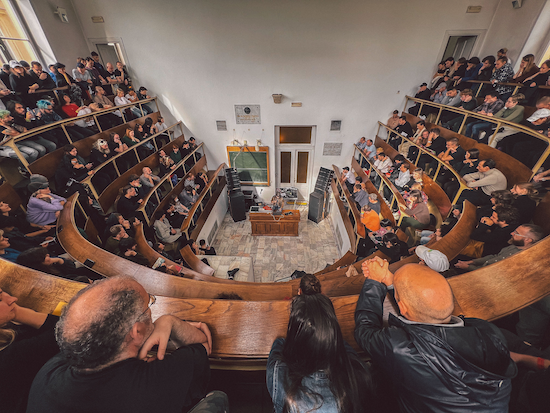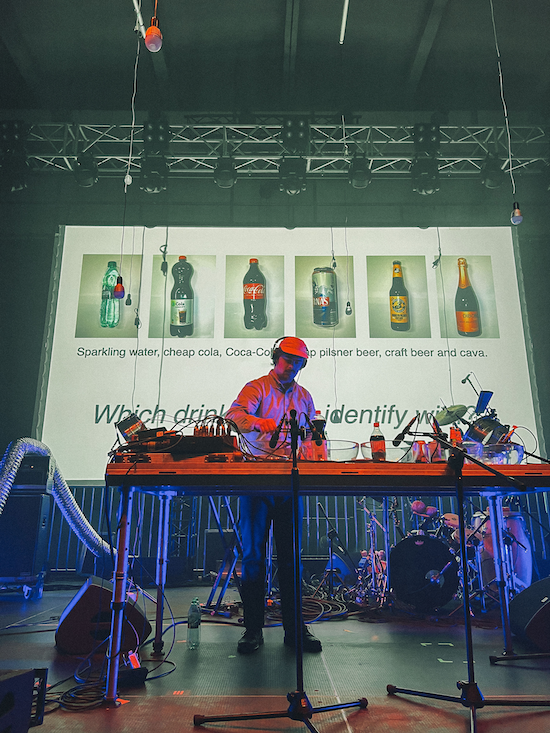Dmytro Nikolaienko, all photos by Jakub Knera
No matter if it’s loosely coiled or tucked away in a cassette, for Dmytro Nikolaienko every tape loop has its place. The producer is carefully removing one after the other and placing it into a tape player or an old reel-to-reel recorder. You can see how carefully he’s gluing the tapes together, and you can hear the results. Some of them are too long, so he uses a pencil or micro tripod in order to hook them on. Krakow’s Unsound Festival had often surprised its participants by organising concerts in unusual spaces, and this year, at the 20th edition of the festival, it did so yet again. We are in a small auditorium at the former building of the Clinic For Internal Diseases, which opened in 1901. Students’ seats are fixed on several steep levels to peer down at what the ‘teacher’ is doing on the wooden desk in the middle.
Nikolaienko, known for establishing the amazing Muscut label, was born in Ukraine but lives in Estonia. He makes hauntological, electronic music, redolent of the way Philip Jeck used his vinyl records. Electronic melodies, sometimes dominated by a strong psychedelic beat, are overshadowed by a sonic haze of dustiness. There is not a moment when he isn’t doing something with his hands, constantly modulating the sound to speed it up or slow it down or changing successive loops, looking for the marks when lifting the curly tapes over his head.
Martyna Basta performs a day earlier in the same room, bathed in the rays of the morning sun. She starts by playing subtle electronic structures, then adds the delicate sound of a small zither while weaving abstract vocals, and eventually grabs a guitar. Although the set recalls Grouper or Claire Rousay, it’s obvious that Basta seeks a language of her own. Her recent records have resembled radio plays, but this performance is more of a fairytale. The experience is surreal.
Unsound’s Morning Glory series, which Basta’s performance is a part of, reverses the standard idea of the concert, the audience arriving before noon, perhaps not fully awake yet. The best performances are those that fit in with this unusual time and place. Lydian Dunbar, for instance, who performs before Basta with successive waves of sound based on electronics and processed and harmonica, is too loud and intense to make a proper impact.
The most interesting concerts at this year’s Unsound are those that explored the balance between two worlds. One of them comes from Heinali (aka Oleg Shpudeiko), who plays on Monday night at Teatr Łaźnia Nowa in Nowa Huta, in the east of the city. Under gleaming red lights, he presents Organa, an intricate polyphonic jigsaw on a modular synthesiser, inspired by organa of the twelfth century Notre Dame school of polyphony. He gradually builds up the music, going from ruptured sounds into a drone-like form that explodes into a massive bass wave resonating throughout the floor.

Martyna Basta
Nikolaienko plays with the old and the new. He uses quasi-unearthed prehistoric recordings, forgotten media, humming reverb, or new electronics, creating a soundtrack to a world falling out of the established order. Heinali, on the other hand, neatly combines modern electronic sounds with medieval inspirations. There are similarities and formal relationships between them, but both musicians take different paths in their vision of post-classical music.
Later, on the same day, there is Oren Ambarchi, Johan Berthling, and Andreas Werliin. Their performance together marks a stark contrast to Heinali. They play a mixture of trance and organic music, which sometimes recalls The Natural Information Society, a more psychedelic The Necks, or a jazzy version of Širom. They celebrate the rhythm and the time of sounds: Berthling delivering a pulse on bass and double bass, Werliin adding layers of instrumentation via his drum kit, and Ambarchi painting picturesque patches on his guitar and table of effects. The trio’s surprising music sticks to a set narrative, even when it explodes just for a few seconds, all the proportions brilliantly maintained. It overshadows the closing act of Coby Sey, whose performance simply isn’t coherent, prompting a thinning out among the audience.
Different worlds and contrasting aesthetics are also present during the performance of Spółdzielnia Muzyczna and Wojciech Rusin, who interpret the material from the latter’s album Syphon in the Krakow Philharmonic Hall, harmonious melodies of strings and reeds interweaving with electronics. Rusin breaks with convention in an amazing way, at one point reveals his famous 3D printed pipes with which they move from punctuated sounds to a quasi-pastoral drone. Then, there are the ridiculous, vaporwave-esque visuals: a crocodile with paws, a mouse-dog, a big rubber duck, a flaming pyramid of cars, or a synchronised dance of bizarre new species.
Rusin clearly puts a lot of thought into what is new and what is old, the ideas of tradition and futurism, and seeks creative juxtapositions. At the end of the set, he inflates a balloon, sticks a pipe to it, and then deflates it to generate sound. In Poland, when the atmosphere gets too serious or lofty, we say you ought to ‘let the air out’ or ‘burst the balloon’; Rusin is great at this. That said, I feel that the concert format is not enough for his work. Maybe an exhibition or sound installation would is required? There are too many contexts, inspirations, and themes to fit in a single show.

Heinali
Rusin and Muzyczna’s performance is followed by another Unsound premiere: Resina and Aho Ssan. Their music is intense and loud. The cellist Resina exploring her interest in amplified violin, with a distinctive undulating sound and vocals full of reverb, while Frenchman Ssan improvises on controllers built himself to create a dense bass shell of varying dynamics, full of distorted electronic sounds. They balance classical music and futurism, which results in a quirky, deep synthesis of cello strings and layered electronics, buzzing music with lyrical elements. It is a great synergy, not only when Resina sits behind the huge organ at the end of the Hall. By the time it ends, however, I’m glad; the intensity of the music almost too overwhelming.
The translation of the past into contemporary language through music is a theme recurring throughout many concerts. EXPAT, a new project by performer and rapper Mykki Blanco (“This is not an art gallery,” they shout to gather the audience closer to the stage) and Samuel Acevedo, mixes spoken word, poetry, guitar solos, and references to pop culture (such as ‘Hate Me Baby One More Time’ and ‘Free your Lady Marmalade’). They create a striking collage about oppression and social inequality, although a shorter performance might have increased its power.
Lucrecia Dalt, meanwhile, presents Ay! – a project exploring tropicália arranged for electronics, vocals, and percussion, while Pimpon, aka Szymon Gąsiorek, delivers a hint of irony. As part of a sound installation, he opens carbonated drinks while commenting on consumerism and class division: who drinks sparkling water, cheap cola, or pilsner, and who drinks craft beer or prosecco?

Pimpon
I have travelled to Krakow with Kate Molleston’s Sound Within Sound in hand, a book devoted to 20th century composers outside the mainstream which draws attention to the under-representation of non-Western artists in global music. She also appears at Unsound for a talk hosted by tQ’s Jennifer Lucy Allan in the Krzysztofory Palace. “Don’t use the word ‘alternative’ because it implies that there is a ‘core’ kind of thing,” Molleston says. Both journalists speak about diversity, ways in which to dig for music and present it to a wider audience.
Molleston admits that many people have asked her about the reasoning behind the choice of the ten artists she focuses on in the book. Someone from the Eastern scene such as Valentina Goncharova could have made a worthy inclusion, for instance, or perhaps Stanislaw Ostoja-Kotkowski, who is introduced as a major inspiration by Robin Fox during a lecture later that day. Born in 1922 in Golub, a small town in eastern-northern Poland that belonged to Prussia at the time, Ostoja-Kotkowski moved to Australia in the 1950s. Ten years later, he worked on transforming sound into colours and shapes, using laser effects in theatrical performances. Among other things, he built the Chromasonic Tower in Adelaide, which reacts to passing traffic with an array of colourful, pulsating lights. Ostoja-Kotkowski was an inspiration for Fox’s Triptych, which premieres at Unsound this year.
During a discussion titled ‘Eastern Promises’ Łukasz Warna-Wiesławski, who makes club music inspired by Polish folklore, presents some statistics on how many local and Eastern artists are invited to perform across the ‘We Are Europe’ group of festivals and the SHAPE+ network. Considering Unsound’s line-up, where 25 per cent of artists are from Poland and another 10 per cent from elsewhere in Eastern Europe, it doesn’t look bad, but overall, the global network could pay more attention to what was happening in those countries that were once behind the Iron Curtain. Especially now, when russia is attacking Ukraine, it makes sense to book Ukrainian artists more often. Not because of their passports, but because of the music they make.
Even though the talks are very interesting, it is a shame that they often take place in bubbles – the artists’ talks on music, the Metaverse, and NFTs are led by a journalist from the West, while the panels on CEE and Ukraine rely on panellists and presenters from the East. On the Eastern-focused panels, there is a lot of pointing out problems, but not as much thought on their solutions. In the future, perhaps a reshuffling of panellists and hosts could deliver new perceptions, viewpoints, and conclusions.
That said, Unsound is still a platform that does not only showcase a variety of genres and artists, but is always open for discussions. There is ragging on the ‘cringe’ of the Nobel Prize grouping winners from Ukraine, Belarus and russia together (as Yulia Krivich does during the ‘Westplanning’ panel), or how Bandcamp, the best tool for direct music sales, doesn’t work in Ukraine as it does on the rest of the continent (as Dima Nikolaienko comments during ‘Dislocation’), or Heinali’s point that when American institutions invite Ukrainian classical musicians, they prefer them to play Western music instead of their own.
I am glad to witness a particularly touching moment when Kyiv-based musician Sasha Zakrevska (aka Poly Chain) recalls 24 February, the day Vladimir Putin ordered the full scale invasion of Ukraine, when her uncle told her to take only the most necessary things with her. “The first one was my synthesizer,” she says. “I can’t imagine leaving home without it.” Oleg Shpudeiko did the same thing. “If I hadn’t thought of it then, I wouldn’t have anything to play here at Unsound.” Please remember that these are their weapons now.


